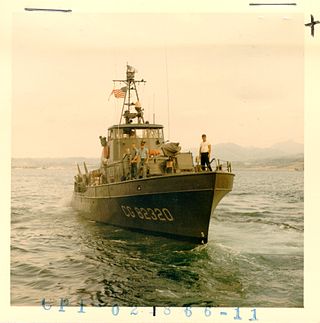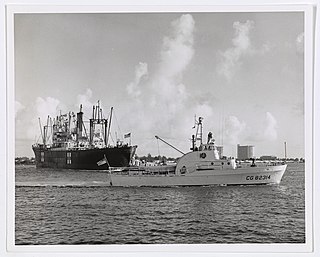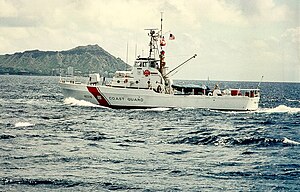USCGC Point Countess (WPB-82335) was an 82-foot (25 m) Point class cutter constructed at the Coast Guard Yard at Curtis Bay, Maryland in 1962 for use as a law enforcement and search and rescue patrol boat. Since the Coast Guard policy in 1962 was not to name cutters under 100 feet (30 m) in length, it was designated as WPB-82335 when commissioned and acquired the name Point Countess in January 1964 when the Coast Guard started naming all cutters longer than 65 feet (20 m).

USCGC Point Brown (WPB-82362) was an 82-foot (25 m) Point class cutter constructed by J.M. Martinac Shipbuilding Corp. at Tacoma, Washington in 1967 for use as a law enforcement and search and rescue patrol boat.
USCGC Point Banks (WPB-82327) was an 82-foot (25 m) Point-class cutter constructed at the Coast Guard Yard at Curtis Bay, Maryland in 1961 for use as a law enforcement and search and rescue patrol boat by the United States Coast Guard. Since the Coast Guard policy in 1961 was not to name cutters under 100 feet (30 m) in length it was designated as WPB-82327 when commissioned and acquired the name Point Banks in January 1964 when the Coast Guard started naming all cutters longer than 65-foot (20 m).
USCGC Point Garnet (WPB-82310) was an 82-foot (25 m) Point class cutter constructed at the Coast Guard Yard at Curtis Bay, Maryland in 1961 for use as a law enforcement and search and rescue patrol boat. Since the Coast Guard policy in 1961 was not to name cutters under 100-foot (30 m) in length, it was designated as WPB-82310 when commissioned and acquired the name Point Garnet in January 1964 when the Coast Guard started naming all cutters longer than 65-foot (20 m).
USCGC Point Caution (WPB-82301) was the first 82-foot (25 m) USCG Point class cutter constructed at the Coast Guard Yard at Curtis Bay, Maryland. She was built and commissioned in 1960 for use as a law enforcement and search and rescue patrol boat. Since the Coast Guard policy in 1960 was not to name cutters under 100 feet (30 m) in length it was designated as WPB-82301 when commissioned and acquired the name Point Caution in January 1964 when the Coast Guard started naming all cutters longer than 65-foot (20 m).
USCGC Point Jefferson (WPB-82306) was an 82-foot (25 m) Point class cutter constructed at the Coast Guard Yard at Curtis Bay, Maryland in 1960 for use as a law enforcement and search and rescue patrol boat. Since the Coast Guard policy in 1960 was not to name cutters under 100 feet (30 m) in length, it was designated as WPB-82306 when commissioned and acquired the name Point Jefferson in January 1964 when the Coast Guard started naming all cutters longer than 65-foot (20 m).

USCGC Point Kennedy (WPB-82320) was an 82-foot (25 m) Point class cutter constructed at the Coast Guard Yard at Curtis Bay, Maryland in 1961 for use as a law enforcement and search and rescue patrol boat. Since the Coast Guard policy in 1961 was not to name cutters under 100-foot (30 m) in length, it was designated as WPB-82320 when commissioned and acquired the name Point Kennedy in January 1964 when the Coast Guard started naming all cutters longer than 65-foot (20 m).
USCGC Point Slocum (WPB-82313) was an 82-foot (25 m) Point class cutter constructed at the Coast Guard Yard at Curtis Bay, Maryland in 1961 for use as a law enforcement and search and rescue patrol boat. Since the Coast Guard policy in 1960 was not to name cutters under 100-foot (30 m) in length, it was designated as WPB-82313 when commissioned and acquired the name Point Slocum in January 1964 when the Coast Guard started naming all cutters longer than 65-foot (20 m).
USCGC Point Hope (WPB-82302) was an 82-foot (25 m) Point class cutter constructed at the Coast Guard Yard at Curtis Bay, Maryland in 1960 for use as a law enforcement and search and rescue patrol boat. Since the Coast Guard policy in 1960 was not to name cutters under 100 feet (30 m) in length, it was designated as WPB-82302 when commissioned and acquired the name Point Hope in January 1964 when the Coast Guard started naming all cutters longer than 65 feet (20 m).
USCGC Point Verde (WPB-82311) was an 82-foot (25 m) Point class cutter constructed at the Coast Guard Yard at Curtis Bay, Maryland in 1961 for use as a law enforcement and search and rescue patrol boat. Since the Coast Guard policy in 1961 was not to name cutters under 100 feet (30 m) in length, it was designated as WPB-82311 when commissioned and acquired the name Point Verde in January 1964 when the Coast Guard started naming all cutters longer than 65 feet (20 m).
USCGC Point Swift (WPB-82312) was an 82-foot (25 m) Point-class cutter constructed at the Coast Guard Yard at Curtis Bay, Baltimore in 1961 for use as a law enforcement and search and rescue patrol boat. Since the Coast Guard policy in 1961 was not to name cutters under 100 feet (30 m) in length, it was designated as WPB-82312 when commissioned and acquired the name Point Swift in January 1964 when the Coast Guard started naming all cutters longer than 65 feet (20 m).
USCGC Point Herron (WPB-82318) was an 82 ft (25 m) Point class cutter constructed at the Coast Guard Yard at Curtis Bay, Maryland in 1961 for use as a law enforcement and search and rescue patrol boat. Since the Coast Guard policy in 1961 was not to name cutters under 100 feet (30 m) in length, it was designated as WPB-82318 when commissioned and acquired the name Point Herron in January 1964 when the Coast Guard started naming all cutters longer than 65 feet (20 m).
USCGC Point Roberts (WPB-82332) was an 82-foot (25 m) Point class cutter constructed at the Coast Guard Yard at Curtis Bay, Maryland in 1962 for use as a law enforcement and search and rescue patrol boat. Since the Coast Guard policy in 1961 was not to name cutters under 100 feet (30 m) in length, it was designated as WPB-82332 when commissioned and acquired the name Point Roberts in January 1964 when the Coast Guard started naming all cutters longer than 65 feet (20 m).

USCGC Point Thatcher (WPB-82314) was an 82-foot (25 m) Point class cutter constructed at the Coast Guard Yard at Curtis Bay, Maryland in 1961 for use as a law enforcement and search and rescue patrol boat. Since the Coast Guard policy in 1961 was not to name cutters under 100 feet (30 m) in length, it was designated as WPB-82314 when commissioned and acquired the name Point Thatcher in January 1964 when the Coast Guard started naming all cutters longer than 65 feet (20 m). Point Thatcher was unique because it was the only cutter that was built in the class that was powered using gas turbine main drive engines.
USCGC Point Ledge (WPB-82334) was an 82-foot (25 m) Point class cutter constructed at the Coast Guard Yard at Curtis Bay, Maryland in 1962 for use as a law enforcement and search and rescue patrol boat. Since the Coast Guard policy in 1962 was not to name cutters under 100 feet (30 m) in length, it was designated as WPB-82334 when commissioned and acquired the name Point Ledge in January 1964 when the Coast Guard started naming all cutters longer than 65 feet (20 m).
USCGC Point Glass (WPB-82336) was an 82-foot (25 m) Point class cutter constructed at the Coast Guard Yard at Curtis Bay, Maryland in 1962 for use as a law enforcement and search and rescue patrol boat. Since the Coast Guard policy in 1962 was not to name cutters under 100 feet (30 m) in length, it was designated as WPB-82336 when commissioned and acquired the name Point Glass in January 1964 when the Coast Guard started naming all cutters longer than 65 feet (20 m).

USCGC Point Chico (WPB-82339) was an 82-foot (25 m) Point class cutter constructed at the Coast Guard Yard at Curtis Bay, Maryland in 1962 for use as a law enforcement and search and rescue patrol boat. Since the Coast Guard policy in 1962 was not to name cutters under 100 feet (30 m) in length, it was designated as WPB-82339 when commissioned and acquired the name Point Chico in January 1964 when the Coast Guard started naming all cutters longer than 65 feet (20 m).
GCGV General Mazniashvili (P211) is a 82-foot (25 m) Point class cutter used by the Coast Guard of Georgia. The boat was originally known as USCGC Point Baker (WPB-82342), having been constructed at the Coast Guard Yard at Curtis Bay, Maryland, in 1963 for use as a law enforcement and search and rescue patrol boat. Since the Coast Guard policy in 1963 was not to name cutters under 100 feet (30 m) in length, it was designated as WPB-82342 when commissioned and acquired the name Point Baker in January 1964 when the Coast Guard started naming all cutters longer than 65 feet (20 m). In 2002 the boat was decommissioned and transferred to the Coast Guard of Georgia where she was commissioned as General Mazniashvili (P211), homeported in Batumi, Georgia.
USCGC Point Judith (WPB-82345) was an 82-foot (25 m) Point class cutter constructed at the J.M. Martinac Shipbuilding Corp. yards at Tacoma, Washington in 1966 for use as a law enforcement and search and rescue patrol boat.
USCGC Point Franklin (WPB-82350) was an 82-foot (25 m) Point class cutter constructed at the J.M. Martinac Shipbuilding Corp. yards at Tacoma, Washington in 1966 for use as a law enforcement and search and rescue patrol boat.




